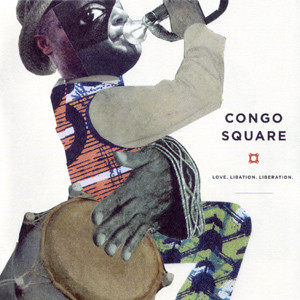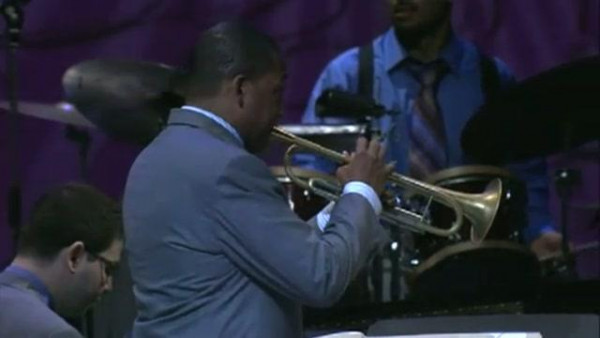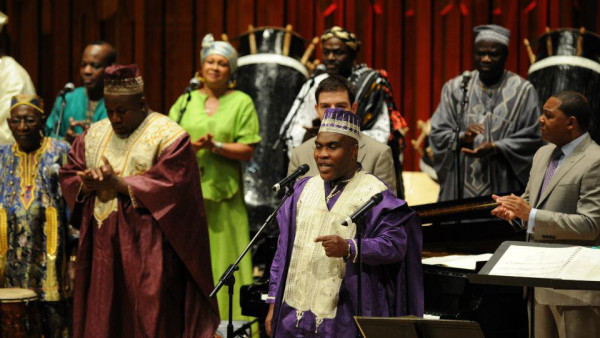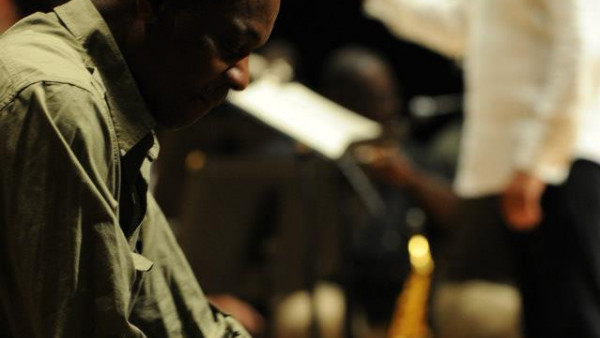Heat combo: When Wynton Marsalis met Yacub Addy
We first saw Wynton Marsalis on television soloing with a symphony orchestra in 1981. The announcer said he came from New Orleans. “I’m going to work with this man,” my husband Yacub Addy said.
I was surprised because Yacub is a traditional Ghanaian drummer of the Ga ethnic group. I couldn’t visualise him working with this classically trained trumpeter, although Wynton is known for jazz, which Yacub loved since he was a teenager in Ghana, dancing to American big band hits on the streets of Accra. His music led him from Ghana to Europe and America, where in 1982, as an artist and manager team, we created his current Ghanaian ensemble Odadaa!.
In 1984 Odadaa! first appeared at the New Orleans jazz festival. Yacub wanted to visit New Orleans since he heard Louis Armstrong talk about his hometown during his visits to Accra in 1953 and 56. We visited Congo Square, an open area in Louis Armstrong Park outside the French Quarter, where we were told African slaves used to play on Sunday afternoons. “What rhythm did the slaves play here?” Yacub asked. No one could tell him.
From the early 1700s to the mid-1800s, Congo Square was the only place in America where African slaves and free-people were allowed to perform their own music and dance. It was because of these regular Sunday afternoon gatherings that African music combined with European music in New Orleans to become the foundation of a line of American musics – jazz, blues, R&B, soul, funk, hip-hop, and so on.
In January 1993, more than a decade after we had seen him on television, Yacub and I met Wynton in the dressings rooms at President Clinton’s Inaugural Festival on the Washington Mall. The two musicians liked each other immediately and Yacub told him they would work together, even though Wynton was unfamiliar with African music.
In 2003 Wynton and Yacub did their first project, a series of original works by Yacub, Wynton, Coltrane and Ellington, titled Africa Jazz, performed by Jazz at Lincoln Center Orchestra (JLCO) and Odadaa!. Both artists discovered how difficult it is to combine their two groups. Their musical forms share elements of syncopation and improvisation, but have very different timing and structure: JLCO performs from sheet music; Odadaa! plays by ear and from memory.
“What music did the slaves play in Congo Square?” Yacub asked when Wynton first arrived at our home to begin working on Africa Jazz. He said no one really knows, but he was sure they could capture that spirit. Their second and significantly larger project, Congo Square, was born.
Jazz at Lincoln Center announced the premiere would take place in Congo Square during the French Quarter festival in April 2006, and four days later, Hurricane Katrina struck. We were all devastated, and Wynton was consumed organising a concert to raise funds for the musicians affected. When it was complete, we decided we would go ahead with the Congo Square premiere.
They decided upon universal themes dealing with the family and the two basic human conditions of peace and war. Yacub contributed the traditional and original works for each theme, taught Wynton the bell patterns on which each rhythm is based, how the bell combines with the drums, and where the other instruments come in. Wynton responded with composition and orchestrations that included concepts Yacub raised of extended family, spirituality, and the all-important bell patterns. They included two pieces from Africa Jazz, which evolved after considerable work into “Ring Shout” and “Place Congo”.
Yacub added the Ga processional Kolomashi, created as protest music during Ghana’s independence struggle, to Wynton’s New Orleans second-line parade music for the opening “Ring Shout”. Wynton’s lyrics express protest at the treatment of the community during Katrina.
Bamai is a difficult rhythm that comes from Yacub’s long-deceased father’s medicine music Ga Akong, played to “call” one of the spirits or jinn that would embody him in trance. In the first rehearsal for Africa Jazz, the idea to combine it with Wynton’s new orchestral piece came immediately to Yacub, who started playing the master or lead drum part on the very instrument used by his father’s drummers all those years ago – a white obrenten drum that is older than he is. It took years before Wynton understood what Yacub was doing. The result is one of my favourite parts of Congo Square.
Through the enormous efforts of many, nine months after Katrina, the vision became a reality. On a Sunday afternoon, in April 2006, a traditional second-line parade through the streets of the historic Treme neighborhood drew a jammin’ local crowd into Congo Square for the performance on a stage constructed for the occasion. Jazz at Lincoln Center Orchestra and Odadaa! played together like family. With survivors of Katrina and the spirits of our ancestors, we celebrated our common heritage.
Audiences of all kinds celebrated Congo Square’s beauty and power in 25 concerts through the US and Canada, including the Montreal jazz festival, and Jazz at Lincoln Center in New York. A late-night recording of the concert in JALC’s Rose Hall was released as a 2-CD set, currently available on iTunes.
Yacub, Wynton and all the artists, love playing this piece – there’s nothing like it. And we’re happy London audiences will have the opportunity to experience the jubilant, dynamic, swingin’ Congo Square.
Source: The Guardian





